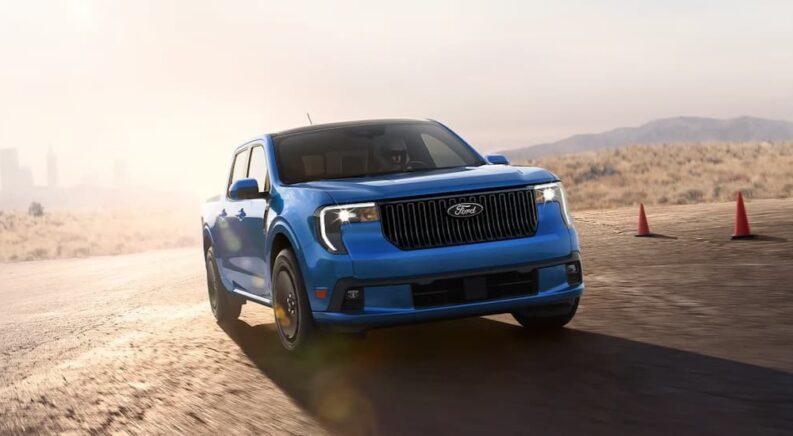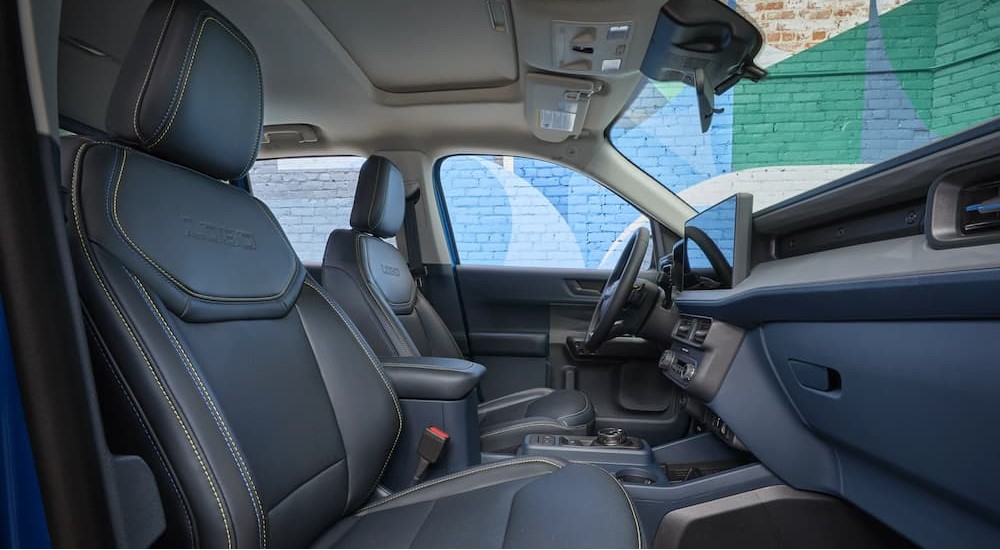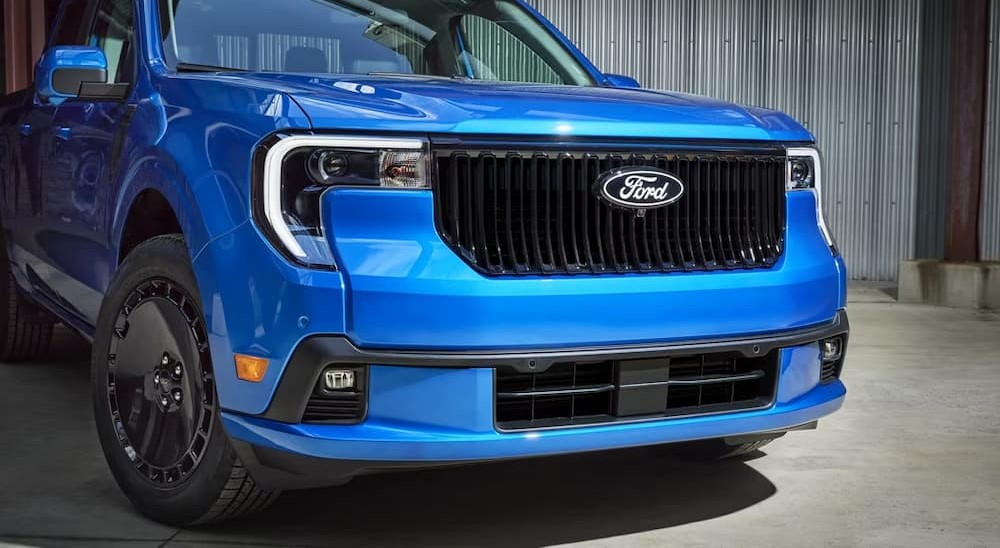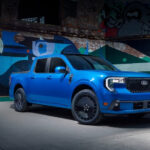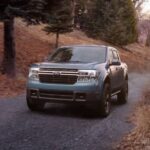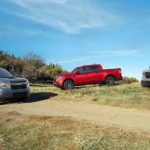A mid-cycle refresh for the 2025 model year has seen the Ford Maverick graced with some compelling updates. The compact pickup made its debut in 2022, and The Big Blue Oval is working to keep things fresh with a new front fascia and headlights, upgraded 13.2-inch touchscreen, and some cutting-edge options like a 360-degree camera system, wireless Apple CarPlay and Android Auto connectivity, and a few towing packages that allow the Maverick to make the most of its 4,000-lb maximum towing capacity. While these enhancements should go a long way towards broadening the Maverick’s appeal for those seeking a reliable, efficient pickup, Ford might have made one major miscalculation in the form of the new Lobo trim.
Street-oriented sport trucks once ruled the road, with models like the Ford F-150 SVT Lightning and GMC Syclone burning rubber and breaking hearts back in the 1980s and early 1990s. However, this approach has largely fallen out of style as drivers increasingly turn to trucks more focused on off-road performance and towing capacity. The Lobo aims to reverse this trend with a sport truck for the modern age, but the early results aren’t too promising.
While Ford has equipped the Lobo with a few performance-enhancing components, it has cut corners in some important areas. The truck’s all-terrain tires aren’t a great fit for the Lobo’s intended use. Although the trim trades on its potential as an autocross model, it isn’t legal in SCCA Solo 2 without some significant modifications. These factors, as well as general consumer indifference about the sport truck category, have led to slow sales for the Maverick Lobo, with current models now selling for less than its original $36,595 MSRP. Is the 2025 Ford Maverick Lobo already a failure, or an underappreciated diamond in the rough? We’ll attempt to answer that question as we explore the trim’s background, review some of the high points, and delve into the lows of the Maverick Lobo.
Covering Its Tracks
We might be a little more forgiving about the Maverick Lobo if it actually seemed like an earnest attempt to resurrect the sports truck formula. A little behind-the-scenes sleuthing suggests this might be more of a shrewd business move than a true passion project. While the Maverick shares the same platform and suspension components with the brand’s Escape compact crossover, a suspicious number of the Lobo’s upgrades seem to be sourced from the recently discontinued Edge. The midsize SUV met its end following the 2024 model year, which is a bit confusing given that the third-generation Edge only hit the market in 2023. Ford claims that the SUV was edged out to make room for larger crossovers and more electrified options, but the timing seems a bit suspect and raises some questions about the brand’s overall strategy.
What do you do when you’re left with a warehouse full of components for a model that only lasted two years into its third generation? Raid the parts bin and roll out a new sport truck trim that nobody asked for. We don’t mean to sound cynical, but it’s hard to ignore the fact that many of the Lobo’s key upgrades seem to be directly sourced from the Edge’s performance-oriented ST trim. For example, it has the same seven-speed automatic transmission as the Edge ST. It also has the same advanced twin-clutch all-wheel drive system. Sure, the Maverick Lobo gains larger brake rotors and dual-piston front brake calipers, paddle shifters, 19-inch wheels, and a sport-tuned suspension that’s been slightly lowered, but it’s difficult to ignore the fact that the Lobo’s two priciest components seem to have been ripped from the Edge ST.
The Highs
If there’s one feature that really makes the case for the Lobo’s sport truck appeal, it would have to be the truck’s torque vectoring all-wheel drive system. Borrowed from the Edge ST, the twin-clutch rear-drive unit can also be found on some of Ford’s most athletic models, like the Maverick Tremor and Bronco Sport. The system works by doling out power where it’s needed most, using the truck’s brakes to control wheelspin and enhance the Lobo’s traction by redirecting torque to the front outside wheel when carving through a corner. It’s essentially a light-duty version of the limited-slip differential found on many off-road models. While it does improve the pickup’s ability to drift, reduce understeer, and make for stable, quick cornering, it’s something of a half-measure by modern standards.
The Maverick Lobo’s other claim to fame is its seven-speed automatic. “It’s the same eight-speed transmission we have today,” Keith Daugherty, Maverick Vehicle Integration Engineer, told Grassroots Motorsports. “There’s a couple of trans ratios that for drivability and fuel economy that make sense, but for pure performance, the ratios are too close so if you’re near redline you end up needing to do a double shift. We recalibrated that transmission so it’s only a seven-speed.” The Edge ST also used this transmission, tuned as a seven-speed for performance.
Retuned shocks and stiffer springs prime the Lobo for on-road applications, while a revised steering ratio improves responsiveness. The new trim also features larger brake rotors and dual-piston front brake calipers courtesy of the Focus ST, which help to keep the truck’s speed in check as you work to achieve a faster lap. The Maverick Lobo also looks every bit the performance model thanks to its unique grille and front-end styling, exclusive synthetic leather upholstery, and a set of 19-inch aero-style alloy wheels. The Lobo benefits from the inclusion of the Ford Co-Pilot360 package, which adds a number of advanced driver-assistance systems (ADAS) to the mix, including blind-spot warning with rear cross-traffic warning, evasive steering assistance, and intersection collision mitigation.
The Low-Bos
There’s no disputing the fact that the Maverick Lobo is a well-rounded trim, but there are a few key drawbacks that call the model’s sport truck credentials into question. The problems start under the hood, where Ford has saddled the Lobo with the same turbocharged 2.0L I-4 found in all but the hybrid trims. While the engine isn’t necessarily underpowered at 250 hp and 277 lb-ft of torque, we would have liked to see the Lobo treated to an upgrade that would match its high-performance ethos. The most frustrating aspect of the trim’s powertrain would have to be its paltry zero-to-60-mph time. While the Maverick Lariat can get up to speed in 6.4 seconds, the heavier Lobo takes 6.9 seconds to reach 60 mph. It also trends below average in stopping distance, needing 139 ft to brake from 60 mph despite its Focus ST brakes, compared to 119 ft for the Maverick Lariat.
Then there’s the suspension. The sport-tuned setup is a nice touch, but the truck has only been lowered by 0.5 inches in the front and 1.1 inches in the rear. These figures hurt the aerodynamic profile, yet still make the Lobo too tall for many sanctioned autocross events. The SCCA Solo RuleBook specifies that a vehicle’s height can not be greater than its track width, which is the distance between the tires. At 67.7 inches tall with a 63.1-inch track width, the Maverick Lobo violates this rule, making it illegal for the same autocross events it was marketed for. It would take a combination of lowering springs to reduce the height and wheel spacers to increase the track width to make the Lobo legal. Ironically, non-ST versions of the Ford Fiesta were banned from autocross competition in 2015 for a similar rollover risk, according to Autoblog. They, like the Lobo, were taller than they were wide.
An exclusive Lobo driving mode further complicates the issue as it’s only designed to be used on closed courses. The feature uses the Lobo’s advanced torque vectoring system and reduces the sensitivity of the stability control system to improve cornering, stability, and traction, but drivers won’t be able to take full advantage of it during their day-to-day driving duties.
The trim’s tires present another issue, as Ford has employed a rather confounding approach when settling on its chosen rubber. The all-terrain Goodyear Wrangler Territory tires are designed with off-road use in mind, and prioritize tread life over grip in a way that’s difficult to justify when trying to craft a sport truck. Throw in the fact that the Lobo notches the lowest towing capacity of any 2025 Maverick model at 2,000 lbs, and it’s tough to see what sort of unique value proposition the truck has to offer.
The Final Verdict
Is Ford just behind the times, or trying to revive the dormant category in hopes of carving out a unique niche in today’s market? Only time will tell if the Maverick Lobo will go down as a failure or a forward-thinking trim. If the numbers are to be believed, the model is off to a rough start.
The Lobo is eerily similar to many of the “soft-road” trims that have clogged the market recently. These trims look every bit the off-road model, but lack the heavy-duty gear needed to succeed on the road less traveled. The Lobo is basically the sport truck version of a soft-roader, and even its torque vectoring all-wheel drive system and seven-speed transmission can’t keep it from totaling up to a minor disappointment.
If you’re trying to dip your toes into the world of autocross or drifting but don’t aim to compete with the big boys, the Maverick Lobo might serve you well, but you won’t end up on the podium without making some serious modifications. This would be understandable if the Lobo fell on the cheaper side of the 2025 trim ladder, but the model’s relatively high MSRP makes it a questionable investment if you’re serious about the sport truck niche. While we applaud Ford for taking a risk and trying to offer something new, the Lobo simply falls short in a few key categories that make it difficult to recommend.

